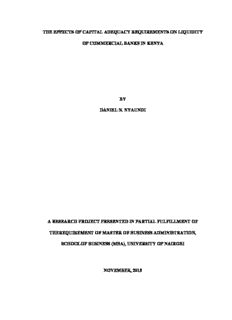
The effects of capital adequacy requirements on liquidity of commercial banks in Kenya PDF
Preview The effects of capital adequacy requirements on liquidity of commercial banks in Kenya
THE EFFECTS OF CAPITAL ADEQUACY REQUIREMENTS ON LIQUIDITY OF COMMERCIAL BANKS IN KENYA BY DANIEL N. NYAUNDI A RESEARCH PROJECT PRESENTED IN PARTIAL FULFILLMENT OF THEREQUIREMENT OF MASTER OF BUSINESS ADMINISTRATION, SCHOOLOF BUSINESS (MBA), UNIVERSITY OF NAIROBI NOVEMBER,2015 i DECLARATION I declare that this research project is my original work and has not been presented for a degree in any other university. Signature…………………………………………..Date………………………………. Daniel N. Nyaundi D61/68330/2013 The research project has been submitted for examination with my approval as the University Supervisor Signature…………………………………………..Date………………………………. Supervisor: Dr. Kennedy Okiro Department of Finance and Accounting School of Business, University of Nairobi ii DEDICATION I dedicate my research work to my family and many friends. A special feeling of gratitude to my loving parents, whose words of encouragement and support has seen me through during the period of my study and to my sister and brothers for their moral support. iii ACKNOWLEDGEMENT My great appreciation and thanks goes to the Almighty God for His grace and good health. Secondly, to my supervisor Dr. Kennedy Okiro who passionately encouraged and guided me professionally throughout the study. I equally salute the University staff, for the adequate and timely resources. Special thanks to dad and mum, and to my sister, brothers and not forgetting the encouragement from my dear friends. iv TABLE OF CONTENTS DECLARATION...............................................................................................................ii DEDICATION..................................................................................................................iii ACKNOWLEDGEMENT...............................................................................................iv LIST OF TABLES............................................................................................................v LIST OF ABBREVIATION...........................................................................................vii ABSTRACT....................................................................................................................viii CHAPTER ONE:INTRODUCTION..............................................................................1 1.1 Background of the Study..............................................................................................1 1.1.1 Capital Adequacy...............................................................................................2 1.1.2 Liquidity..............................................................................................................4 1.1.3 Relationship between Capital Adequacy and Liquidity.....................................5 1.1.4 Commercial Banks in Kenya..............................................................................6 1.2 Research Problem.........................................................................................................8 1.3 Research Objective.....................................................................................................10 1.4 Value of the Study......................................................................................................10 CHAPTER TWO:LITERATURE REVIEW...............................................................12 2.1 Introduction.................................................................................................................12 2.2 Theoretical Review.....................................................................................................12 2.2.1 Financial Intermediation Theory........................................................................12 2.2.2 The Financial Fragility Theory..........................................................................13 2.2.3 The Risk Absorption Theory.............................................................................14 2.2.4 Theory of Bank Liquidity Requirements...........................................................15 2.3 Determinants of Capital Adequacy Ratio...................................................................16 2.3.1 Risk Level..........................................................................................................16 2.3.2 Alternative Cost of the Capital..........................................................................16 2.3.3 Share of Deposits in Non-Equity Liabilities......................................................17 2.3.4 The Average Capital Adequacy of the Sector....................................................17 2.3.5 Economic Growth..............................................................................................18 ii 2.4 Empirical Review........................................................................................................18 2.5 Summary of Literature Review...................................................................................25 CHAPTER THREE:RESEARCH METHODOLOGY..............................................26 3.1 Introduction.................................................................................................................26 3.2 Research Design..........................................................................................................26 3.3 Target Population........................................................................................................26 3.4 Data Collection...........................................................................................................27 3.5 Data Analysis..............................................................................................................27 3.5.1 Model and Variable..................................................................................................27 CHAPTER FOUR:DATA ANALYSIS AND INTERPRETATION..........................30 4.1 Introduction.................................................................................................................30 4.2 Data Analysis and Findings........................................................................................30 4.2.1 Findings on Capital Adequacy Ratio ofCommercial Banks.............................30 4.2.2 Size of the Bank.................................................................................................31 4.2.3 GDP Growth Rate..............................................................................................32 4.3 Correlation Analysis...................................................................................................35 4.4 Estimated or Empirical Model....................................................................................37 4.5 Discussion of the Findings..........................................................................................39 CHAPTER FIVE:SUMMARY, CONCLUSION AND RECOMMENDATIONS...42 5.1 Introduction.................................................................................................................42 5.2 Summary of the Findings............................................................................................42 5.3 Conclusion..................................................................................................................43 5.4 Policy Recommendations............................................................................................45 5.5 Limitations of the Study..............................................................................................46 5.6 Suggestions for Further Research...............................................................................46 REFERENCES................................................................................................................47 iii APPENDICES.................................................................................................................51 Appendix 1: List of Commercial Banks in Kenya...........................................................51 Appendix II: Secondary Data............................................................................................53 iv LIST OF TABLES Table 4.1: Size of the Bank...............................................................................................31 Table 4.2: GDP growth rate..............................................................................................33 Table 4.3: Correlation.......................................................................................................36 Table 4.4: Model Summary..............................................................................................37 Table 4.5: Summary of One-Way ANOVA results..........................................................38 Table 4.6: Coefficients......................................................................................................38 v LIST OF FIGURES Figure 4.1: Descriptive Statistics on Capital Adequacy...................................................30 vi LIST OF ABBREVIATION CIS- Credit Information Sharing CBK- Central Bank of Kenya CAR- Capital Adequacy Ratio GDP- Gross Domestic Product MFI- Micro Finance Institutions R2- R-squared ROE- Return on Equity RWA- Risk weighted Average vii
Description: